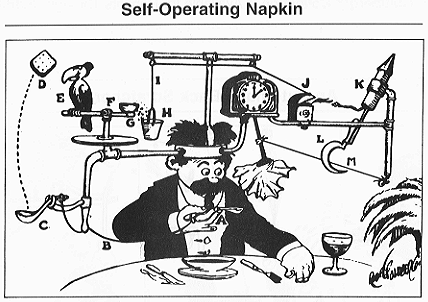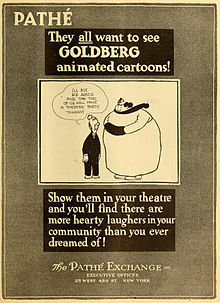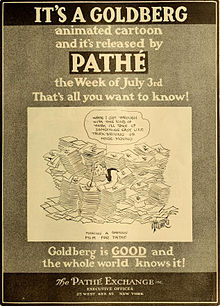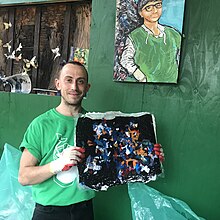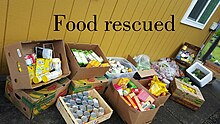Rube Goldberg
| |
|---|---|

c. 1916
| |
| Born |
Reuben Garrett Lucius Goldberg
July 4, 1883
San Francisco, California
|
| Died | December 7, 1970 (aged 87) |
| Resting place | Mount Pleasant Cemetery in Hawthorne, New York |
| Alma mater | UC Berkeley |
| Occupation | Engineer, sculptor, news reporter, cartoonist |
| Known for | Rube Goldberg machines |
| Website | rubegoldberg |
Something for Nothing (1940)
Reuben Garrett Lucius Goldberg (July 4, 1883 – December 7, 1970), known best as Rube Goldberg, was an American cartoonist, sculptor, author, engineer, and inventor.
Goldberg is best known for his popular cartoons depicting
complicated gadgets performing simple tasks in indirect, convoluted
ways. The cartoons led to the expression "Rube Goldberg machines" to describe similar gadgets and processes. Goldberg received many honors in his lifetime, including a Pulitzer Prize for political cartooning in 1948, the National Cartoonists Society's Gold T-Square Award in 1955, and the Banshees' Silver Lady Award in 1959. He was a founding member and first president of the National Cartoonists Society and the namesake of the Reuben Award, which the organization awards to its Cartoonist of the Year. He is the inspiration for international competitions known as Rube Goldberg Machine Contests which challenge participants to create a complicated machine to perform a simple task.
Personal life
Goldberg was born in San Francisco, California, to Jewish parents Max and Hannah (Cohen) Goldberg.
He was the third of seven children, three of whom died as children;
older brother Garrett, younger brother Walter, and younger sister
Lillian also survived. Goldberg began tracing illustrations when he was four years old, and first took professional drawing lessons when he was 11.
Goldberg married Irma Seeman on October 17, 1916. They lived at 98 Central Park West in New York City and had sons Thomas and George. During World War II,
Goldberg insisted that his sons change their surname because of the
amount of hatred towards him stemming from the political nature of his
cartoons.
Thomas chose the surname of George, in order to honor his brother;
George, wanting to keep a sense of family cohesiveness, adopted the same
surname.
Career
Rube Goldberg with family, 1929
Goldberg's father was a San Francisco police and fire commissioner,
who encouraged the young Reuben to pursue a career in engineering. Rube
graduated from the University of California, Berkeley in 1904 with a degree in Engineering and was hired by the city of San Francisco as an engineer for the Water and Sewers Department. After six months he resigned his position with the city to join the San Francisco Chronicle where he became a sports cartoonist. The following year, he took a job with the San Francisco Bulletin, where he remained until he moved to New York City in 1907, finding employment as a cartoonist with the New York Evening Mail.
The New York Evening Mail was syndicated to the first newspaper syndicate, the McClure Newspaper Syndicate,
giving Goldberg's cartoons a wider distribution, and by 1915 he was
earning $25,000 per year and being billed by the paper as America's most
popular cartoonist. Arthur Brisbane had offered Goldberg $2,600 per year in 1911 in an unsuccessful attempt to get him to move to William Randolph Hearst's newspaper chain, and in 1915 raised the offer to $50,000 per year. Rather than lose Goldberg to Hearst, the New York Evening Mail matched the salary offer and formed the Evening Mail Syndicate to syndicate Goldberg's cartoons nationally.
In 1916, Goldberg created a series of seven short animated films, finding humorous aspects to details of everyday life in the form of an animated newsreel. The seven films were released on these dates in 1916: May 8, The Boob Weekly; May 22, Leap Year; June 5, The Fatal Pie; Jun 19, From Kitchen Mechanic to Movie Star; July 3, Nutty News; July 17, Home Sweet Home; July 31, Losing Weight.
Goldberg was syndicated by the McNaught Syndicate from 1922 until 1934.
A prolific artist, Goldberg produced several cartoon series simultaneously, including Mike and Ike (They Look Alike), Boob McNutt, Foolish Questions, What Are You Kicking About, Telephonies, Lala Palooza, The Weekly Meeting of the Tuesday Women's Club, and the uncharacteristically serious soap-opera strip, Doc Wright, which ran for 10 months beginning January 29, 1933.
The strip that brought him lasting fame was The Inventions of Professor Lucifer Gorganzola Butts, A.K., which ran in Collier's Weekly
from January 26, 1929 to December 26, 1931. In that series, Goldberg
drew labeled schematics of the comically intricate "inventions" that
would later bear his name.
The idea for Professor Butts came from a couple of college professors
he studied with (and found boring) while earning his degree from the
College of Mining and Engineering at the University of California from
1901 to 1903, Samuel B Christie and Frederick Slate.
From 1938 to 1941, Goldberg drew two weekly strips for the Register and Tribune Syndicate: Brad and Dad (1939–1941) and Side Show (1938–1941).
Starting in 1938, Goldberg worked as the editorial cartoonist for the New York Sun. He won the 1948 Pulitzer Prize for Editorial Cartooning for a cartoon entitled "Peace Today". He moved to the New York Journal-American in 1949 and worked there until his retirement in 1963.
Cultural legacy
The popularity of Goldberg's cartoons was such that the term "Goldbergian" was in use in print by 1915, and "Rube Goldberg" by 1928. "Rube Goldberg" appeared in the Random House Dictionary of the English Language in 1966 meaning "having a fantastically complicated improvised appearance", or "deviously complex and impractical." The 1915 usage of "Goldbergian" was in reference to Goldberg's early comic strip Foolish Questions
which he drew from 1909 to 1934, while later use of the terms
"Goldbergian", "Rube Goldberg" and "Rube Goldberg machine" refer to the
crazy inventions for which he is now best known from his strip The Inventions of Professor Lucifer Gorgonzola Butts, drawn from 1914 to 1964.
The corresponding term in the UK was, and still is, "Heath Robinson", after the English illustrator with an equal devotion to odd machinery, also portraying sequential or chain reaction elements. The Danish equivalent was the painter, author and cartoonist Robert Storm Petersen, better known under his pen name Storm P. To this day, an overly complicated and/or useless object is known as a Storm P.-machine in Denmark.
Professor Butts and the Self-Operating Napkin (1931)
Goldberg's work was commemorated posthumously in 1995 with the inclusion of Rube Goldberg's Inventions, depicting his 1931 "Self-Operating Napkin" in the Comic Strip Classics series of U.S. postage stamps.
Film and television
Advertisement (1916)
Advertisement (1916)
Rube Goldberg wrote a feature film featuring his machines and sculptures called Soup to Nuts, which was released in 1930 and starred Ted Healy and the pre-Curly Howard version of The Three Stooges.
In the 1962 John Wayne movie Hatari!, an invention to catch monkeys by character Pockets, played by Red Buttons, is described as a "Rube Goldberg."
In the late 1960s and early 70s, educational shows like Sesame Street, Vision On and The Electric Company routinely showed bits that involved Rube Goldberg devices, including the Rube Goldberg Alphabet Contraption, and the What Happens Next Machine.
Various other films and cartoons have included highly complicated machines that perform simple tasks. Among these are Flåklypa Grand Prix, Looney Tunes, Tom and Jerry, Wallace and Gromit, Pee-wee's Big Adventure, The Way Things Go, Edward Scissorhands, Back to the Future, Honey, I Shrunk the Kids, The Goonies, Gremlins, the Saw film series, Chitty Chitty Bang Bang, The Cat from Outer Space, Malcolm, Hotel For Dogs, the Home Alone film series, Family Guy, American Dad!, and Waiting...
Also in the Final Destination film series the characters often die in Rube Goldberg-esque ways. In the film The Great Mouse Detective,
the villain Ratigan attempts to kill the film's heroes, Basil of Baker
Street and David Q. Dawson, with a Rube Goldberg style device.
The classic video in this genre was done by the artist duo Peter Fischli & David Weiss in 1987 with their 30-minute video Der Lauf der Dinge or The Way Things Go.
Honda produced a video in 2003 called "The Cog" using many of the same principles that Fischli and Weiss had done in 1987.
In 2005, the American alternative rock/indie band The Bravery
released a video for their debut single, "An Honest Mistake," which
features the band performing the song in the middle of a Rube Goldberg
machine.
In 1999, an episode of The X-Files was titled "The Goldberg Variation".
The episode intertwined characters FBI agents Mulder and Scully, a
simple apartment super, Henry Weems (Willie Garson) and an ailing young
boy, Ritchie Lupone (Shia LaBeouf) in a real-life Goldberg device.
The 2010 music video "This Too Shall Pass – RGM Version" by the rock band OK Go
features a machine that, after four minutes of kinetic activity, shoots
the band members in the face with paint. "RGM" presumably stands for
Rube Goldberg Machine.
2012 The CBS show Elementary features a machine in its opening sequence.
2014 The Web Series, Deadbeat, on Hulu features an episode
titled, "The Ghost in the Machine," which features the protagonist,
Kevin, helping the ghost of Rube Goldberg complete a contraption that
will bring his grandchildren together after making a collection of
random items into a machine that ends up systematically injuring two of
his grandchildren so they end up in the same hospital and finally meet.
Games
Both board games and video games have been inspired by Goldberg's creations, such as the 60's board game Mouse Trap, the 1990s series of The Incredible Machine games, and Crazy Machines. The Humongous Entertainment game Freddi Fish 2: The Case of the Haunted Schoolhouse involves searching for the missing pieces to a Rube Goldberg machine to complete the game.
In 1909 Goldberg invented the "Foolish Questions" game based on
his successful cartoon by the same name. The game was published in many
versions from 1909 to 1934.
Rube Works: The Official Rube Goldberg Invention Game, the first game authorized by The Heirs of Rube Goldberg, was published by Unity Games (the publishing arm of Unity Technologies) in November 2013.


